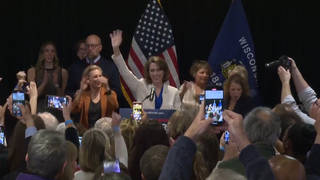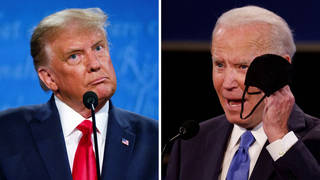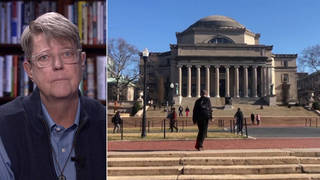
As the official U.S. COVID-19 death toll breaks worldwide records and passes 250,000, hospitals are at capacity, and overwhelmed healthcare workers still lack personal protective equipment. Health officials say conditions will worsen further with holiday travel and family gatherings for Thanksgiving. “I can’t really overemphasize how important the next few days are,” says Ed Yong, science writer at The Atlantic. “The people who get infected at Thanksgiving, they are going to slam into those hospitals in the two weeks after that, and some of those people are going to be dead before Christmas.”
Transcript
AMY GOODMAN: The official U.S. death toll from COVID-19 has passed a quarter of a million people as the virus rages out of control from coast to coast, with 172,000 infections and nearly 2,000 deaths reported on Wednesday alone. U.S. hospitalizations continue to shatter records, with over 73,000 COVID-19 patients. The average daily death toll is rising in 33 states.
But as COVID breaks every record here in the United States with expected holiday spikes still to come, Health and Human Services Secretary Alex Azar said Wednesday he will not work with President-elect Joe Biden until the General Services Administration declares an election winner. HHS staffers have been directed to not communicate with Biden’s team. Biden said the move could delay vaccine distribution by weeks or even months.
This comes amidst reports of hospitals reaching capacity and overwhelmed healthcare workers and a lack of personal protective equipment reminiscent of the first months of the pandemic. Biden spoke with frontline workers on a video call Wednesday. This is part of his emotional exchange with Mary Turner, an intensive care unit nurse, president of the Minnesota chapter of National Nurses United. As she spoke, Biden wiped away a tear.
MARY TURNER: Do you know that I have not been tested yet, and I have been on the frontlines in the ICU since February?
PRESIDENT-ELECT JOE BIDEN: You’re kidding me.
MARY TURNER: No. We also need safe staffing of nurses in the hospital units. And patients who are or may be COVID-positive patients must be isolated from the general patient population. Workers who have been exposed or who are sick need to be allowed to quarantine at home, without fear of losing income and their jobs. This is a novel virus, but the principles of infection control are not. Our hospitals have not been providing these basic protections. …
Nurses across the country were so relieved and grateful, Mr. President-elect, when you committed to taking action that we need to have to get this pandemic under control. …
You know, we nurses, we know that we are facing immense death and suffering in the coming weeks. And we will be there. But we need to act now. We need to act quickly to protect our healthcare workers, so that we can save as many lives as possible. Thank you.
PRESIDENT-ELECT JOE BIDEN: Mary —
MARY TURNER: I’m sorry I’m so emotional.
PRESIDENT-ELECT JOE BIDEN: No.
MARY TURNER: It’s just —
PRESIDENT-ELECT JOE BIDEN: You got me emotional.
AMY GOODMAN: That’s President-elect Joe Biden responding to Mary Turner, president of the Minnesota chapter of National Nurses United.
Well, for more, we’re going to Washington, D.C., where we’re joined by Ed Yong. He’s science writer at The Atlantic, his latest story headlined “'No One Is Listening to Us': More people than ever are hospitalized with COVID-19. Health-care workers can’t go on like this.”
Ed Yong, we’re nearing 2,000 people in a day dying in this country, by far shattering every record in the world for COVID-19. Your latest piece focuses on healthcare workers. Meanwhile, President Trump remains bunkered down in the White House. For 12 days, he has had no public events, and on his schedule to come, no public events to be seen. Can you talk about the state of this country right now? It’s not about what could have been, though that is an absolutely critical issue to look at, but what is happening right now. There are many days that President Trump will remain president, that mean that thousands and thousands of people will die.
ED YONG: Yeah, I can’t really overemphasize how important the next few days are. So, let me paint the full picture for you. It’s really interesting you said Trump has been closed off 12 days, because that number is important. There is typically a 12-day lag between rises in cases and rises in hospitalizations. And that means that all the stories you’ve just heard, that ICU nurse, all the stories about hospitals in the Midwest being completely at capacity and unable to cope, that doesn’t even account for the one-and-a-half million people who have been confirmed as infected over the last 12 days. Some of those people will slam into those hospitals, that are already unable to cope with what they have right now, over the next two weeks into Thanksgiving. And the people who get infected at Thanksgiving, they are going to slam into those hospitals in the two weeks after that, and some of those people are going to be dead before Christmas. That is what we are looking at. We are looking at enormous tragedy.
And I cannot — it’s really hard to explain how nurses and doctors are dealing with this. I have spent the last couple of weeks interviewing many of them around the country. I’ve had nurses crying to me down the phone. A nurse told me — a nurse who works in a cancer ward told me earlier this week that she cannot even process — she doesn’t even know how to process the amount of death that she is seeing on the COVID wards. One of the best-prepared hospitals in the entire country, in Nebraska, has turned an entire tower into COVID units. They’re dealing with so many more patients, in general and specifically COVID patients, than they’ve ever had to deal with.
NERMEEN SHAIKH: Well, Ed Yong, in your piece about medical workers, in addition, of course, to the burnout that you speak of, there is also the issue of the effects of the politicization of the pandemic and the Trump administration’s response. You write in the recent piece that, quote, “Health-care workers and public-health officials have received threats and abusive messages accusing them of fearmongering.” So, in addition to these extremely injurious effects on nurses and on doctors, they’re also being abused.
ED YONG: They are being abused. They’re being harassed. Public health officials are taking the brunt of this. But even if you — you know, say you’re not getting harassed and abused. You’re still — you know, some of the people I’ve talked to are still spending 12-hour shifts in the ICU. They’re watching patients die on them. They’re having to zip those patients up in body bags. And then they end those shifts, and they drive home past rows of packed restaurants, past packed sporting venues, past people having parties and going out to bars. That is emotionally devastating. You know, these are the people who are trying to save everyone’s lives. They are inundated. They are exhausted. And at the end of the day, they are forced to watch the people who will likely be in their ICUs and adding to their burden in about two weeks’ time. And that social fatigue of having to deal with a society that isn’t doing its part is crushing.
People I’ve spoken to have said that in the spring, when this first started, they were energetic, and they had a sense of purpose and drive to them. And partly that was buoyed by the fact that other people were doing their part and everyone was in it together. But we’re past the days now when people were clapping for healthcare workers in the evening. People have forgotten, and pandemic fatigue has set in. And that means that healthcare workers, who have been at this for the entire year, almost without a break, and who are now exhausted, feel like they’ve been left alone by the very public that they are trying to save.
NERMEEN SHAIKH: Ed, we’ve been talking now, of course, about infections, but principally about deaths in the U.S. and how the U.S. stands out. It’s number one in the world in terms of deaths. But you wrote earlier, in August, in a piece about long haulers, so-called COVID long haulers. This was in August. Could you talk about what long haulers are and what we’ve learned since August about this condition, which afflicts not just people who are older and more vulnerable, but also, as you’ve said in that piece, people who were previously healthy and also the young?
ED YONG: Yeah. So, a lot of COVID patients have had ongoing symptoms for many months now, well past the period where supposedly mild COVID is meant to finish. These symptoms are often not severe enough to send them into an ICU, but they are certainly severe enough to debilitate their lives. They include neurological problems, like brain fog; crushing fatigue that prevents them from doing even the simplest tasks and that makes daily activity — like, even mild amounts of physical and mental activity can send them into a big physiological crash.
Like many other people with related chronic illnesses, like dysautonomia or myalgic encephalomyelitis, long haulers have often been dismissed by the medical establishment and neglected. But they have been pushing for their own recognition. They’ve been doing research on their own community. They have got the attention of the NIH and the WHO. And they are forming communities and pushing and advocating for themselves.
The really stark thing here is that we know that a certain proportion, a still unidentified proportion, of people who get COVID-19 will end up in this bucket. And with millions of people being infected now at an ever faster rate than ever, we are looking at a huge proportion of people who are still going to be suffering from the consequences of COVID-19 well into next year, and maybe for even longer than that. We are looking at a really, really large toll of long-term disability, that I don’t think America is even remotely ready for.
AMY GOODMAN: Ed, can you talk about the Trump administration refusing to communicate with the incoming Biden administration, what exactly this means? That Emily Murphy, who, apparently, day to day, is deciding what to do — yes, she must take orders from the Trump administration, but every individual can make their own decision about what they want to do if it involves, for example, saving lives, where she would do the — sign off on an ascertainment that means that the Biden administration can start to plan, like a relay race, where you don’t stop and then take a baton and run — you are running alongside the runner behind you, and you take the baton from them. We’re at a point right now where Biden is saying this could set back, for example, the distribution of the vaccine, not only weeks, but by months. That’s just one part of this. Talk about the significance of this, as President Trump hides away in the White House.
ED YONG: Well, it’s just another of a long line of decisions that the Trump administration has made that has severely hampered the U.S.’s ability to control this very controllable, very preventable crisis. None of this should be playing out in the way that it has, and it is because of the utter incompetence of this administration throughout the entire year. And it seems like having lost the recent election, they show no signs of charting a different course.
It is really unfortunate, because for the first time, I think, true hope is on the horizon. We have an administration coming in that has vowed to take this seriously, that has appointed actual medical experts to its task force, that has a plan that just reads very much like all the other roadmaps and plans that experts have been pushing for the last year. We have the promise of two very effective vaccines on the horizon. And while, of course, we await actual data on those, the early signs look very, very promising, perhaps far better than a lot of experts had been hoping for. And so, the light at the end of the tunnel is brighter than ever, but the tunnel itself is incredibly dark. Some healthcare systems are going to collapse. And those death rates that you have seen are going to get even higher when that happens, when doctors and nurses simply cannot any longer take care of every patient. We are approaching that point, where they will have to choose who to save and who to let die.
And so, you know, it is a problem, of course, that Trump is not aiding the Biden transition, but we cannot wait for that point. We cannot wait for a new administration to come in, in January. And even in this interregnum, it falls upon not just the Biden transition team and task force, it falls upon all of us to do our part. It falls upon all of us to cancel our travel plans. It calls upon us to stay away from other people in indoor spaces who aren’t from our households. Indoor spaces are the best way — indoor spaces provide some of the best conditions for the virus to transmit — bars, restaurants, gyms, house parties, dinner parties. These are the means through which SARS-CoV-2 virus spreads easily, and we need to avoid those for the immediate future. We need to hunker down, and we need to distance ourselves from each other, even at this painful time when we really want to be seeing and gathering and hugging our families, because if we don’t, many parts of our country’s healthcare system are just going to collapse within the next few months, before those signs of hope, before the new administration and before vaccines start coming into play.
NERMEEN SHAIKH: Well, Ed Yong, as you have talked about, the vaccine is giving hope — not just the two possibly very successful vaccines are giving hope not just to people in the U.S., but also, of course, around the world. But I’d like to ask about some of the problems that many countries — in fact, the majority of countries in the world — will face in accessing these vaccines, number one having to do with distribution, because both vaccines require storage and transportation in subzero temperatures; and second, the question of intellectual property rights — there are a number of developing countries, led by India and South Africa, that are pushing for the suspension of property rights with respect to the COVID-19 vaccine to make the vaccine more accessible to the majority of countries in the world; and lastly, the fact that rich countries have already bought up almost the majority — I think 46% — of projected vaccine doses, leaving many in the world to anticipate receiving this vaccine only several years from now. So, could you talk about some of the issues, some of the problems, that this lack of access might create, not just for people around the world outside the rich countries, but also for the rich countries, if such large numbers of people don’t receive the vaccine?
ED YONG: Yeah. So, to be clear, this is not something I personally reported on, so I don’t want to stray outside what I know. My colleague Sarah Zhang has written some credible pieces about vaccines and some of the logistical problems going forward.
What I will say is that a pandemic, obviously, is a global issue, and countries cannot be fighting it alone. America is in a weird position here, because it has uniquely botched its response to this vaccine and is in worse straits than a lot of other places in the world with much fewer resources. But, you know, the traditional posture of trying to help the rest of the world and being part of this global community still stands. There are agreements and alliances that are meant to ensure equitable international distribution of vaccines to get the entire pandemic under control around the world, on the understanding that if any one country is vulnerable, every country is vulnerable. The U.S. should, I hope, in future, in the coming administration, sign up to those alliances and be part of its place within the global community. But it also needs a massive dose of humility here. You know, gone are the days when it is the big player offering aid and advice and expertise to the rest of the world. The U.S. is in a position where it has as much to learn from other countries as it has to teach.
I will add that, yes, the problems of distributing a vaccine and allocating it fairly within the U.S. and more broadly are substantial. And they mean that these vaccines, when they get approved, which hopefully won’t be too long from now, that’s not going to be the end of the pandemic. It’s not going to be a matter of flipping a light switch and restoring the world of 2019 that we have longed for. It is going to be a slow process of gradually rolling out doses around the country and around the world, slowly ramping up immunity and slowly bringing this thing under control.
The end is in sight. We do have an endgame. But it is going to be a long endgame, and we are only going to begin that process soon. And in that time, we will still need all the public health measures that have been insufficient thus far. We need testing. We need access to rapid diagnostic tests, that can make a huge difference in controlling this pandemic. We will need contact tracing. We will need social interventions, like paid sick leave. We will need clear communication from people in charge. And we will need some measure of physical distancing still for many months to come, to prevent the kinds of healthcare system collapses that we are facing right now.
NERMEEN SHAIKH: Before we conclude, I want to ask you about something you wrote about in an October piece, namely that whoever wins the election — so, we know now, the Biden-Harris administration — will probably have to deal with another major epidemic during their term in office. Could you explain why you think that’s the case?
ED YONG: Because that has been case for every administration in recent history. So, take Barack Obama. In his two terms, he had to deal with MERS, another coronavirus, the H1N1 flu pandemic. He had to deal with Zika, and he had to deal with the massive, historic Ebola outbreak in West Africa. Now, of course, not all of those epidemics hit the U.S., but many of them did. And the current pandemic shows just how easily a new disease can affect the entire world.
We live in an age of epidemics, where new viruses are coming out all the time, when old foes are popping their — are resurging to threaten us once more. And this is not a problem, therefore, that we can expect to go away at any time, at any time soon. Those of us fortunate enough to survive the COVID-19 pandemic will almost certainly experience more pandemics in our lifetimes, certainly more epidemics that we need to worry about.
And I just can’t overstate how important this is. I wrote a piece in The Atlantic in 2018 about the need to prepare for pandemics and the fact that the U.S. was not prepared enough. And look around you. Clearly, that was the case. And I’m saying to you now that we still have holes to fix. We have gaps in our preparedness. We have seen how overstretched our hospitals are, how underfunded our public health systems are, how vulnerable prisons and nursing homes and meatpacking plants can be, how poorly ventilated a lot of our buildings are, how long-lasting some of the injustices that have plagued the country for decades and centuries are that have now led to people of color, Indigenous communities, disabled communities and elderly communities being disproportionately hit by this virus. We have a lot to fix before the next big epidemic hits us.
AMY GOODMAN: Ed, if you have a big family dinner for Thanksgiving, can you expect a small funeral for Christmas?
ED YONG: I would prefer if you don’t have a large family dinner at all. Look, I know we really want to see our families. I miss my family. I miss my friends. I have not seen most of them since the start of the year, and even longer than that. But if you gather indoors, if multiple generations gather indoors, speaking loudly, for days on end, in close contact, without masks, those are the perfect conditions for spreading this coronavirus. And as I said, a lot of the people who get infected in Thanksgiving are going to be rushing into hospitals in the middle of December, possibly finding no staff or beds available to them, and they will be in the morgue by Christmas. That is how this virus acts. It works in a predictable way that we have seen throughout the entire year.
If you can, try and be safer. And if you can, try just to cancel your plans full stop. If we went to have a nice Thanksgiving in 2021, which we should be able to because of a better administration and because of vaccines, then we need to make the right choices this year. You don’t want to be at the Thanksgiving table in 2021 looking at an empty chair from the person who you lost based on bad decisions this year.
AMY GOODMAN: Ed Yong, thanks so much for being with us. We’re going to link to all your pieces at The Atlantic, your latest piece, “'No One Is Listening to Us.'”
When we come back, is President Trump trying to make plans to attack Iran before he leaves office? Stay with us.
[break]
AMY GOODMAN: “Life Is Good Again” by Dolly Parton. Earlier this year, she made a $1 million donation that’s being credited with helping Moderna develop its promising COVID-19 vaccine.












Media Options